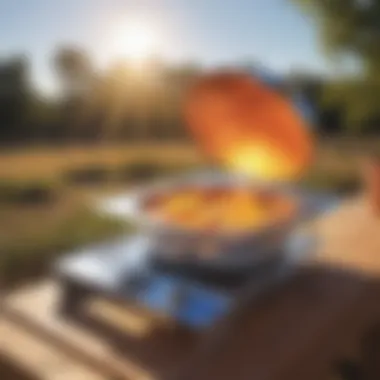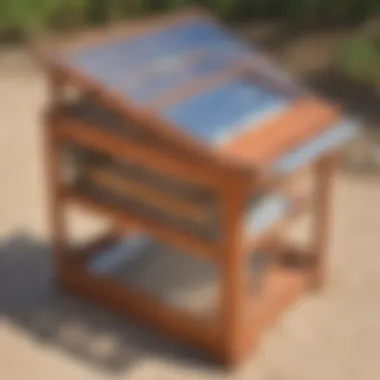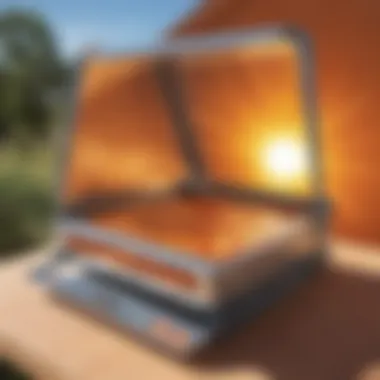Harnessing Solar Power: The DIY Sun Oven Method for Eco-Friendly Cooking


Science Fun Facts
Solar power, a renewable energy source harnessed through photovoltaic cells, offers a sustainable and eco-friendly way to cook food using a DIY sun oven. The sun's rays are transformed into heat, allowing for the creation of delicious meals without traditional energy sources.
Discover the Wonders of Science
Delve into the scientific marvel of solar power and its application in culinary pursuits through sun ovens. Explore how sunlight can be converted into thermal energy that powers cooking processes, reducing the carbon footprint and promoting sustainability in everyday life.
Science Quiz Time
Engage in interactive quizzes that test your knowledge on solar energy, eco-friendly cooking practices, and the principles behind sun ovens. Challenge yourself with brain teasers and puzzles that promote learning through fun and gamification, fostering a deeper understanding of renewable energy sources.
Science Experiment Showcase
Embark on a hands-on journey with DIY sun oven experiments. Follow step-by-step instructions to construct a sun oven using common materials, ensuring safety with detailed precautions. Witness the transformation of sunlight into cooking power through exciting and engaging experiments that highlight the wonders of solar energy.
Introduction to DIY Sun Oven
In this enlightening article, we delve into the fascinating realm of DIY sun ovens - a brilliant method of utilizing solar power for culinary purposes. Harnessing the immense potential of the sun's energy, constructing and using a sun oven not only offers a sustainable cooking solution but also opens a doorway to understanding renewable energy applications in everyday life. The importance of exploring DIY sun ovens lies in their ability to promote eco-conscious cooking practices, reduce reliance on traditional fuel sources, and embrace a greener lifestyle. By comprehending the principles behind solar cooking, individuals can take significant steps towards a more sustainable future.
Understanding Solar Cooking
Solar Energy as a Renewable Resource
Solar energy stands out as a beacon of sustainability, offering an abundant and clean source of power for various applications. In the context of solar cooking, utilizing it as a renewable resource presents a multitude of advantages. The key characteristic of solar energy lies in its inexhaustible nature, providing a consistent and eco-friendly energy source for cooking. Embracing solar energy in DIY sun ovens not only reduces carbon footprint but also aligns with the ethos of promoting renewable energy practices. The unique feature of solar energy lies in its accessibility and adaptability, making it a popular choice for eco-conscious individuals seeking an alternative cooking solution.
History of Solar Cooking


The history of solar cooking traces back to ancient civilizations where ingenious methods were employed to harness the sun's heat for culinary purposes. This rich legacy not only showcases human ingenuity but also underscores the time-honored tradition of utilizing solar energy for cooking. The key characteristic of solar cooking history is its evolution from simple solar cookers to sophisticated DIY sun ovens, reflecting mankind's continuous quest for sustainable solutions. The unique feature of solar cooking history lies in its cultural significance and global adoption, highlighting the universal appeal of harnessing solar power for sustainable living.
Advantages of Solar Cooking
Delving into the advantages of solar cooking unveils a plethora of benefits that extend beyond environmental sustainability. From energy savings to healthier cooking practices, the benefits of solar cooking are manifold. The key characteristic of solar cooking advantages is its ability to reduce dependence on conventional fuels, leading to significant cost savings in the long run. Embracing solar cooking brings about advantages such as minimal carbon emissions, enhanced flavors in cooked dishes, and the joy of engaging in eco-friendly culinary practices. The unique feature of solar cooking advantages lies in its holistic approach towards sustainability, encompassing environmental, economic, and health benefits for individuals and communities.
Concept of DIY Sun Oven
Basic Components
At the core of a DIY sun oven are its basic components, each playing a crucial role in harnessing solar power for cooking. From the reflective surface that captures sunlight to the insulating materials that retain heat, every component contributes to the oven's efficiency. The key characteristic of basic components in a sun oven is their functionality and durability, ensuring optimal performance in harnessing solar energy. By understanding and utilizing these components effectively, individuals can construct a reliable and sustainable cooking device that aligns with their eco-friendly aspirations.
Working Principle
The working principle of a DIY sun oven revolves around utilizing solar energy to generate heat for cooking. By harnessing the sun's rays through reflective surfaces and focusing them on the cooking container, the oven creates a thermal chamber for food preparation. The key characteristic of the working principle lies in its simplicity and effectiveness, offering a straightforward yet powerful solution for solar cooking. The unique feature of the working principle is its efficiency in converting solar energy into heat, providing a sustainable and eco-friendly alternative to conventional cooking methods.
Building Your DIY Sun Oven
Materials Needed
Reflective Surface:
The reflective surface is a crucial element in your DIY sun oven as it helps in harnessing and maximizing solar energy for cooking. Reflective surfaces typically consist of mirrored materials that redirect sunlight towards the cooking container, enhancing its temperature. One key characteristic of an effective reflective surface is its high reflectivity, ensuring minimal energy loss during the cooking process. This reflective surface choice is popular for its efficiency in concentrating sunlight, aiding in faster cooking times. A notable advantage of using a reflective surface is its ability to withstand high temperatures without deteriorating, making it a durable and reliable option for solar cooking.
Insulating Material:
The insulating material plays a vital role in maintaining consistent cooking temperatures within the sun oven. It serves to trap heat generated by the sun, preventing dissipation and ensuring even cooking. An essential characteristic of insulating materials is their heat retention capability, which supports long cooking durations without external heat sources. This choice is popular for its heat-resistance and lightweight properties, making it ideal for DIY sun ovens. However, one potential disadvantage of insulating material is its vulnerability to moisture absorption, which can impact its insulating effectiveness in humid environments.
Cooking Container:


The cooking container is the vessel where food is placed for solar cooking and must be chosen carefully for optimal results. The key characteristic of a cooking container lies in its material composition, which should facilitate even heat distribution and retention for thorough cooking. Common choices for cooking containers include dark-colored pots or pans, as they absorb heat efficiently. Dark materials aid in quicker cooking times by absorbing sunlight energy effectively. However, a disadvantage of using a dark-colored cooking container is its potential for overheating if not monitored closely during the cooking process.
Step-by-Step Construction
Preparing the Box:
Preparing the box entails transforming a regular enclosed structure into a functional sun oven. This process involves securing the inner chambers of the box to prevent heat leakage and reinforce its insulating properties. An essential feature of preparing the box is creating a snug and airtight interior to enhance heat retention and cooking efficiency. One unique aspect of this step is customizing the box's interior dimensions to accommodate the reflective surface and cooking container securely.
Installing Reflective Surface:
Installing the reflective surface involves affixing the reflective material inside the box to optimize sunlight absorption. Positioning the reflective surface at an angle that directs sunlight towards the cooking container is critical for effective solar cooking. The key characteristic to focus on during installation is the smoothness and cleanliness of the reflective surface to ensure maximum light reflection. This choice is popular among DIY enthusiasts for its simplicity and cost-effectiveness in transforming ordinary boxes into sun ovens.
Adding Insulation:
Adding insulation to the sun oven is essential for maintaining consistent cooking temperatures and preventing heat loss. The insulation material should be layered around the inner walls of the box, excluding the cooking chamber, to create a thermal barrier. An important characteristic of insulation is its thickness and density, which determines its heat-trapping capabilities. This step is beneficial for increasing the efficiency of the sun oven by reducing heat dispersion and prolonging cooking times. However, one disadvantage of insulation is its bulkiness, which may limit the internal space available for larger cooking containers.
Utilizing Your Sun Oven Efficiently
Utilizing your sun oven efficiently is crucial for maximizing the benefits of solar cooking. By understanding how to optimize its performance, you can enjoy sustainable cooking with minimal resources. One key element in efficient use is positioning the oven correctly to capture the most sunlight possible throughout the day. This ensures that your food cooks evenly and in a timely manner. Adjusting the oven's position as the sun moves can help maintain optimal cooking temperatures. Another essential aspect is adjusting the oven for the sun's angle to prevent shadows from hindering the cooking process. By following these techniques, you can make the most of your sun oven and enjoy delicious meals with minimal environmental impact.
Optimizing Sunlight Capture
Positioning the Oven
Positioning the oven plays a vital role in maximizing sunlight capture for efficient cooking. Placing the oven in a location where it receives direct sunlight for most of the day is essential. Avoiding obstructions like trees or buildings that can cast shadows is crucial. Positioning the oven at an angle facing the sun's path ensures maximum exposure. This strategic placement allows the oven to harness solar energy effectively, providing consistent heat for cooking. While positioning the oven requires regular adjustment to follow the sun's trajectory, the benefits of well-cooked meals using renewable energy make it a worthwhile practice.
Adjusting for Sun Angle


Adjusting the sun oven for the sun's angle is a technique that optimizes its performance. As the sun changes position throughout the day, adjusting the oven to have the maximum surface area exposed to sunlight is essential. This adjustment ensures that the oven receives direct sunlight, enhancing its heating capacity. By aligning the oven perpendicular to the sun's rays, you can achieve optimal heat absorption. While continuous adjustment may be needed to account for the changing position of the sun, the result is efficiently cooked meals using clean energy sources.
Cooking Techniques
Cooking Times
Determining the appropriate cooking times when using a sun oven is critical for preparing delicious meals. Solar cooking typically takes longer than conventional methods due to reliance on sunlight for heat. Understanding the average cooking times for different dishes helps in planning meals. Patience is key when using a sun oven, allowing the natural heat to tenderize food slowly. While longer cooking times may be required, the slow cooking process enhances flavors and retains nutrients in the dishes, resulting in healthier meals.
Recipes Suitable for Sun Oven
Selecting recipes suitable for sun ovens is essential for successful solar cooking. Opting for dishes that require low to medium heat and longer cooking times works best with this method. Recipes that involve simmering, braising, or baking are ideal for sun ovens. Additionally, using darker pots or containers aids in faster cooking as they absorb more sunlight. Experimenting with recipes that suit the gentle nature of solar cooking can lead to flavorful and nutritious meals. By choosing recipes carefully, you can fully maximize the benefits of cooking with a sun oven.
Benefits and Sustainability of DIY Sun Ovens
DIY Sun Ovens offer a plethora of benefits and contribute significantly to sustainability efforts. By harnessing solar power for cooking, individuals reduce their carbon footprint while promoting renewable energy. The environmental impact of DIY Sun Ovens is substantial as they help mitigate the use of traditional energy sources. Embracing this technology not only benefits the environment but also fosters a sense of eco-consciousness among users. Endorsing cost-efficiency and long-term savings, DIY Sun Ovens are a step towards a greener future.
Environmental Impact
Reduced Carbon Footprint
Reducing one's carbon footprint is a pivotal aspect of sustainability. DIY Sun Ovens achieve this by eliminating the need for conventional energy sources, thus lowering greenhouse gas emissions. The key characteristic of reducing carbon footprint through solar cooking is its direct impact on curbing environmental degradation. This choice is highly beneficial for eco-warriors aiming to make a tangible difference in their daily lives. The unique feature of reduced carbon footprint lies in its ability to align personal actions with environmental preservation goals.
Promotion of Renewable Energy
Encouraging the use of renewable energy sources such as solar power is integral to promoting sustainable practices. DIY Sun Ovens exemplify this by utilizing the abundant and clean energy of the sun for culinary purposes. The notable characteristic of promoting renewable energy is its long-term positive effects on the ecosystem. This choice is popular due to its holistic approach to energy consumption and conservation. The unique feature of promoting renewable energy highlights the shift towards greener alternatives for a more sustainable future.
Cost-Efficiency and Long-Term Savings
No Electricity Costs
One of the standout features of DIY Sun Ovens is their ability to reduce electricity costs effectively. By solely relying on solar power, users can save significantly on their utility bills. The key characteristic of zero electricity costs is its immediate impact on household expenses and overall budgeting. This choice proves highly beneficial for individuals seeking sustainable cooking solutions without added financial strain. The unique feature of no electricity costs underscores the practicality and affordability of solar cooking.
Durability of Sun Ovens
The durability of Sun Ovens is a fundamental aspect that enhances their value and longevity. Built to withstand various weather conditions, these ovens are designed for long-term use. The key characteristic of sun ovens' durability is their resilience and robust construction, ensuring consistent performance over time. This choice is popular for those looking for a reliable and lasting cooking solution. The unique feature of sun ovens' durability lies in their ability to endure continuous use without compromising cooking efficiency.







